| |
 The Raglan deposit (indicated in the adjacent map) is a nickel copper deposit located on the Ungava peninsula of northern Quebec, Canada. Exploration and drilling has been ongoing since the 1960's, and the data set considered herein was gathered under the direction of Falconbridge Ltd. The property is 55 km long with a series of ore deposits scattered along its length. Geology was well constrained at outcrops but details about intervening structures and susceptibility were required. This case history considers geophysical results from the Falconbridge Katinniq deposit in the center of the property. Geological reserves at Raglan total 19.3 million tonnes at 3.14% nickel and 0.88% copper. A summary of the development process is provided in Dufresne, 1996. The Raglan deposit (indicated in the adjacent map) is a nickel copper deposit located on the Ungava peninsula of northern Quebec, Canada. Exploration and drilling has been ongoing since the 1960's, and the data set considered herein was gathered under the direction of Falconbridge Ltd. The property is 55 km long with a series of ore deposits scattered along its length. Geology was well constrained at outcrops but details about intervening structures and susceptibility were required. This case history considers geophysical results from the Falconbridge Katinniq deposit in the center of the property. Geological reserves at Raglan total 19.3 million tonnes at 3.14% nickel and 0.88% copper. A summary of the development process is provided in Dufresne, 1996.
Katinniq deposits are hosted by an ultramafic lens 150 metres thick and about 2500 metres long that occur at the contact between volcanic rock and an underlying gabbro-sedimentary sequence. Mineralization extends from surface to at least 150 metres depth, and 1% finely disseminated Fe-Ni-Cu sulphides occur in most parts of the Katinniq Peridotite complex. Economic mineralization is apparently confined to several specific horizons in the vicinity of the basal contact within footwall embayments and near the base of several overlying flow units. It is thought that the embayments with the majority of sulphide mineralization represent a series of northwest plunging thermal erosion channels transgressed by faults. It is still uncertain how much of the geometry of the embayments is attributable to thermal erosion and how much is attributable to faulting.
| The total-field aeromagnetics data are shown to the right, and the two regions of high magnetic field are associated with ultramafic outcrops shown in the accompanying geology map (click the buttons to select images). The red X marks the location of the drill hole discussed later in the text. To see large images of these data in a separate window, click the links indicated in the captions.
The geology map covers the same area as the aeromagnetics map. The magnetic units are the ultramafics (10 and 10d) in purple.
|
 |
| © UBC-GIF
January 9, 2007
|
|
|
|
|

